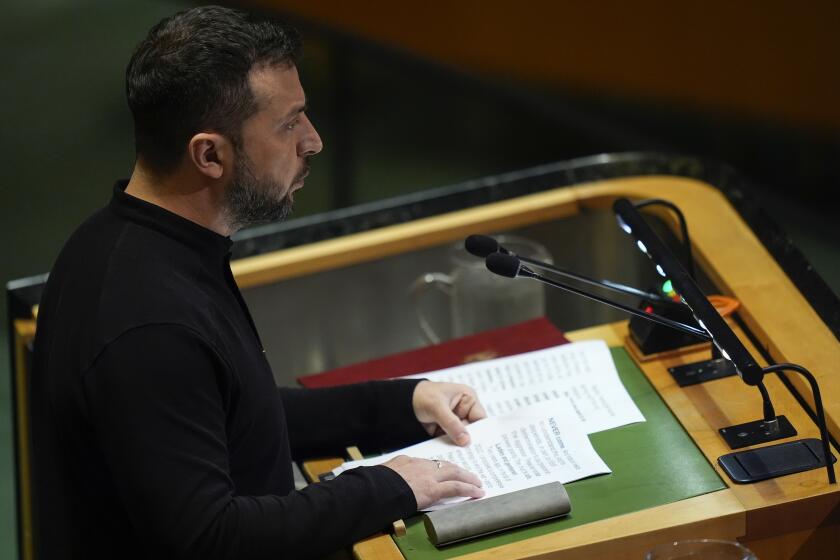FDR’s unfinished business
THE IDEA OF LABOR DAY -- first in the states and later as a federal holiday -- dates to the 1880s, when the notion of “the workingman” took root in American life. But the seeds of organized labor’s strength -- and perhaps of its revival -- can be found in 1933, in the thrilling “First Hundred Days” of President Franklin D. Roosevelt. That was when unions first won, almost by accident, the right to collective bargaining.
Roosevelt didn’t start out as a labor man. As assistant secretary of the Navy during World War I, he worked to keep unions from striking in shipyards, and labor didn’t figure much in his early campaigns. But by 1932, his tremendous intellectual curiosity was beginning to change his thinking. Ed Flynn, the “boss of the Bronx” and a thoughtful public official, launched a series of private conversations with then-Gov. Roosevelt about Pope Leo XIII’s landmark 1891 encyclical, a breathtakingly liberal document that insisted all men had a “natural right” to form unions and to receive a “just wage.” Soon after, FDR began lacing his speeches with such ideas, even though the bulk of the Democratic Party was still in the grips of conservative economic thinking.
“Every man has a right to life, and this means that he also has a right to make a comfortable living,” Roosevelt told the Commonwealth Club of San Francisco in September 1932. “He may by sloth or crime decline to exercise that right, but it may not be denied to him.” This was a new and revolutionary idea in American politics.
Despite such rhetoric, FDR was unwilling to go down the line with labor after he first became president. When he put 275,000 men to work in the Civilian Conservation Corps in his first four months in office, his Labor secretary, Frances Perkins, objected strenuously to their $1-a-day wages. The president of the American Federation of Labor, William Green, said the CCC (which eventually planted 3 billion trees and was dubbed Roosevelt’s “tree army”) smacked “of Fascism, of Hitlerism, of a form of Sovietism.” Green later opposed Social Security on the grounds that it was up to labor, not government, to win social benefits for workers.
Roosevelt also sparred with John L. Lewis, head of the United Mine Workers of America, and even resisted the pleas of teachers for more money from the states. (As a sign of how bad the Depression had become, Chicago teachers were not paid for the entire 1932-33 school year). Although teachers unions held little power then, FDR would almost certainly resent their efforts today to shield their members from accountability for performance. Such accountability, after all, was one of the hallmarks of his presidency.
But FDR nonetheless used the early days of his presidency to launch huge structural changes. In introducing the Securities Act of 1933, he wrote: “This proposal adds to the ancient rule of ‘caveat emptor’ [let the buyer beware] the further doctrine of ‘let the seller also beware.’ ” For the first time, publicly traded companies were required to disclose their financial condition accurately. This new system of transparency became the foundation of the U.S. economy and, later, the global economy. But it also had the unintended effect of allowing unions to know the profits of most of the companies with which they were negotiating.
The big change for labor came at the end of FDR’s first 100 days. When Sen. Hugo Black introduced legislation requiring that no one be allowed to work more than 30 hours a week (the faulty idea being that this would create more jobs), FDR had to come up with something in response. His answer was the National Industrial Recovery Act of 1933, a bill that regulated every aspect of the economy with a series of anti-competitive and unworkable codes. (The codes were so ludicrous that they even regulated the burlesque industry as to how many times a night a stripper could take off her clothes). Buried in the bill was vague language inserted by Sen. Robert Wagner of New York at the last minute when almost no one was looking.
Section 7(a) came to be known as the Magna Carta of the labor movement. For the first time, it gave labor the right “to organize and bargain collectively.” Two years later, the Wagner Act of 1935 solidified that right and created the National Labor Relations Board to investigate unfair labor practices. In 1938, Congress enacted the first minimum wage. Even though the Taft-Hartley Act of 1948 restricted some labor rights, the template had already been set for labor relations for the rest of the century.
FDR had no inkling that a post-industrial economy would prove so hostile to labor, to the point that membership in unions has dropped from 31.8% in 1948 to 12.5% last year. If you exclude public employee unions, only 6.7% of the workforce in the private sector was unionized in 2005.
But he did sense that the new social contract he established in 1933 would need to be updated. In his 1944 State of the Union address, he called for a “second Bill of Rights” that included not just a living wage and freedom from unfair competition, but “political rights” to homeownership, medical care and education.
After many years of steep decline, some parts of the labor movement are growing again, particularly in the service sector. The breakup of the AFL-CIO in 2005 is less a sign of labor’s weakness than of its increasing willingness to think anew, as many unions are doing in supporting comprehensive immigration reform.
Might the unfinished business of Franklin Roosevelt be back on the table? Whatever the results of the midterm elections, one can sense at least a slight shift left, in the struggle over Wal-Mart’s low wages, fresh thinking about the medically uninsured and new recognition of a “middle-class squeeze.” Amid the hot dogs and back-to-school sales on Labor Day, a different kind of politics may be slouching toward Washington to be reborn.
More to Read
Sign up for Essential California
The most important California stories and recommendations in your inbox every morning.
You may occasionally receive promotional content from the Los Angeles Times.










